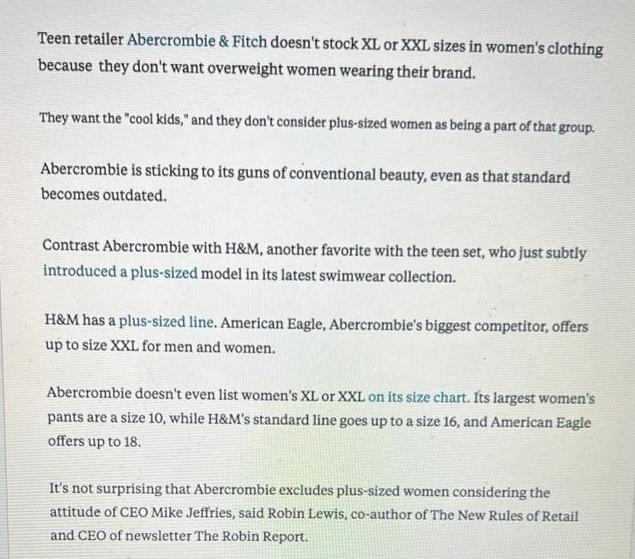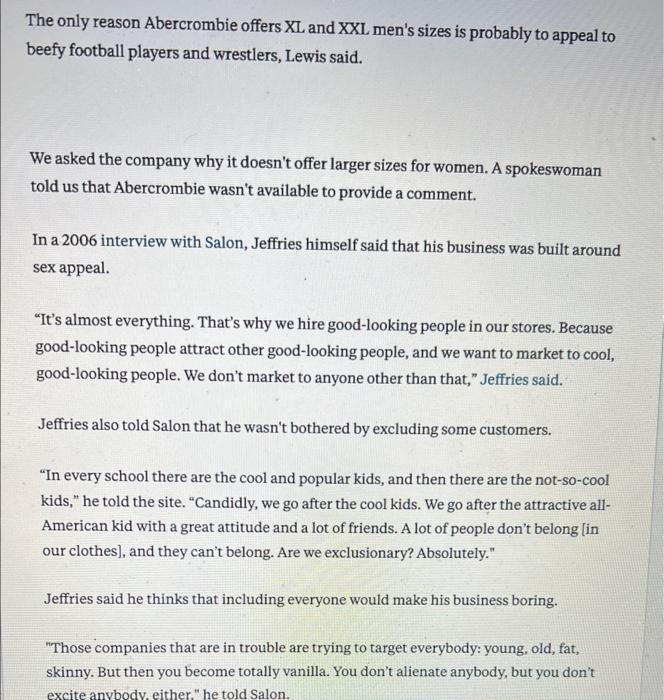Answered step by step
Verified Expert Solution
Question
1 Approved Answer
Teen retailer Abercrombie & Fitch doesn't stock XL or XXL sizes in women's clothing because they don't want overweight women wearing their brand. They




Teen retailer Abercrombie & Fitch doesn't stock XL or XXL sizes in women's clothing because they don't want overweight women wearing their brand. They want the "cool kids," and they don't consider plus-sized women as being a part of that group. Abercrombie is sticking to its guns of conventional beauty, even as that standard becomes outdated. Contrast Abercrombie with H&M, another favorite with the teen set, who just subtly introduced a plus-sized model in its latest swimwear collection. H&M has a plus-sized line. American Eagle, Abercrombie's biggest competitor, offers up to size XXL for men and women. Abercrombie doesn't even list women's XL or XXL on its size chart. Its largest women's pants are a size 10, while H&M's standard line goes up to a size 16, and American Eagle offers up to 18. It's not surprising that Abercrombie excludes plus-sized women considering the attitude of CEO Mike Jeffries, said Robin Lewis, co-author of The New Rules of Retail and CEO of newsletter The Robin Report. The only reason Abercrombie offers XL and XXL men's sizes is probably to appeal to beefy football players and wrestlers, Lewis said. We asked the company why it doesn't offer larger sizes for women. A spokeswoman told us that Abercrombie wasn't available to provide a comment. In a 2006 interview with Salon, Jeffries himself said that his business was built around sex appeal. "It's almost everything. That's why we hire good-looking people in our stores. Because good-looking people attract other good-looking people, and we want to market to cool, good-looking people. We don't market to anyone other than that," Jeffries said. Jeffries also told Salon that he wasn't bothered by excluding some customers. "In every school there are the cool and popular kids, and then there are the not-so-cool kids," he told the site. "Candidly, we go after the cool kids. We go after the attractive all- American kid with a great attitude and a lot of friends. A lot of people don't belong [in our clothes], and they can't belong. Are we exclusionary? Absolutely." Jeffries said he thinks that including everyone would make his business boring. "Those companies that are in trouble are trying to target everybody: young, old, fat, skinny. But then you become totally vanilla. You don't alienate anybody, but you don't excite anybody, either," he told Salon. Plus-sized is no longer a niche market: 67 percent of the apparel purchasing population fit that label, and the number is growing all the time. For too long, this sizable and growing segment has been ignored," writes Margaret Bogenrief at ACM Partners. "Treated shabbily, ostracized by the "pro-skinny fashion world," and seemingly discarded by designers, department stores, and retailers alike, plus-size fashion consumers, critics, and bloggers are taking back their spending and sartorial power and, in turn, changing both the e-commerce and retailing landscapes." Ignoring this "revolution" could be costly for businesses, Bogenrief writes. More brands are featuring curvy, "real-sized," models. In addition to H&M's Jennie Runk, Dove's wildly popular "Real Beauty" campaign highlights women who aren't as thin as traditional models. Abercrombie & Fitch case 1. Do you consider the actions detailed in the case ethical, unethical, or a gray area? Explain your choice. 2. Which of the actions would you do? Why or why not? 3. Which would you feel uncomfortable doing, and why? 4. Which would you refuse to do, and why? 5. Which ethical rights/standards may be violated by your action or inaction?. 6. Describe any other impact that could be caused by this action/inaction.
Step by Step Solution
There are 3 Steps involved in it
Step: 1
1 The actions detailed in the case could be considered unethical or at least a gray area The decisio...
Get Instant Access to Expert-Tailored Solutions
See step-by-step solutions with expert insights and AI powered tools for academic success
Step: 2

Step: 3

Ace Your Homework with AI
Get the answers you need in no time with our AI-driven, step-by-step assistance
Get Started


